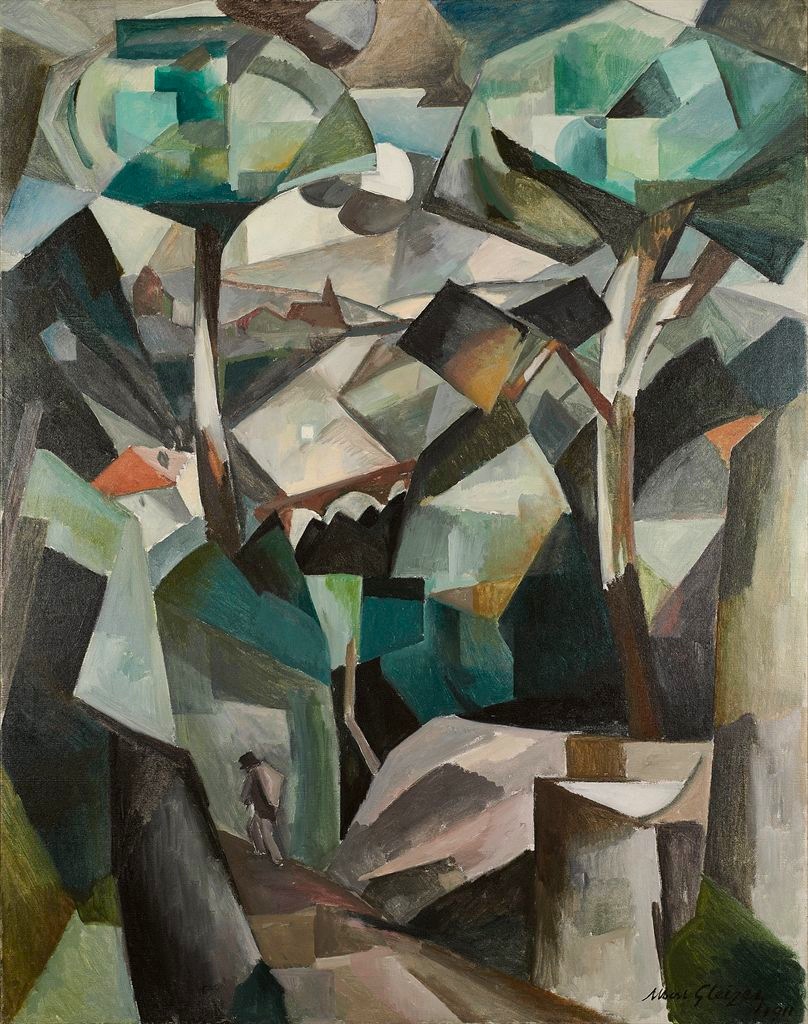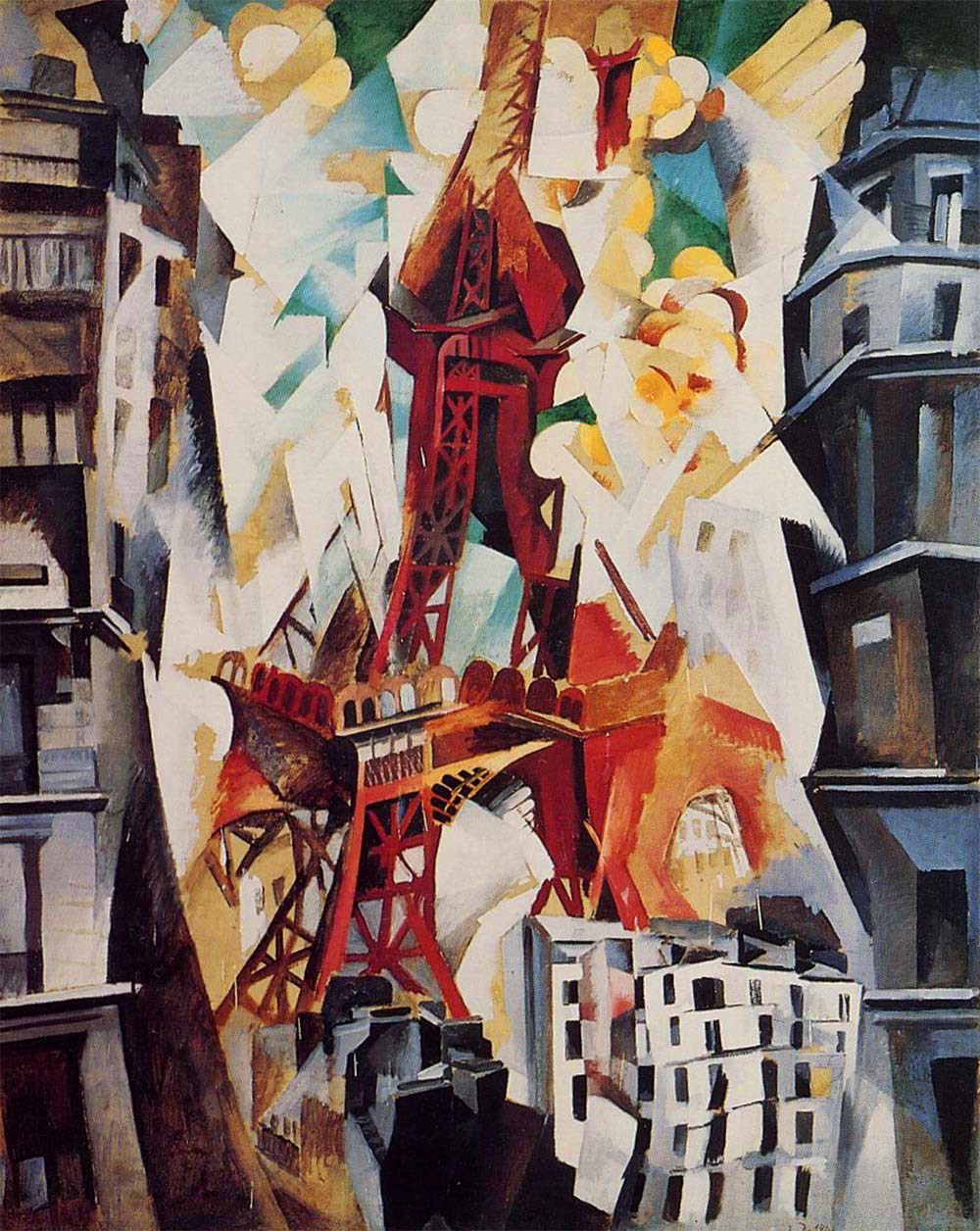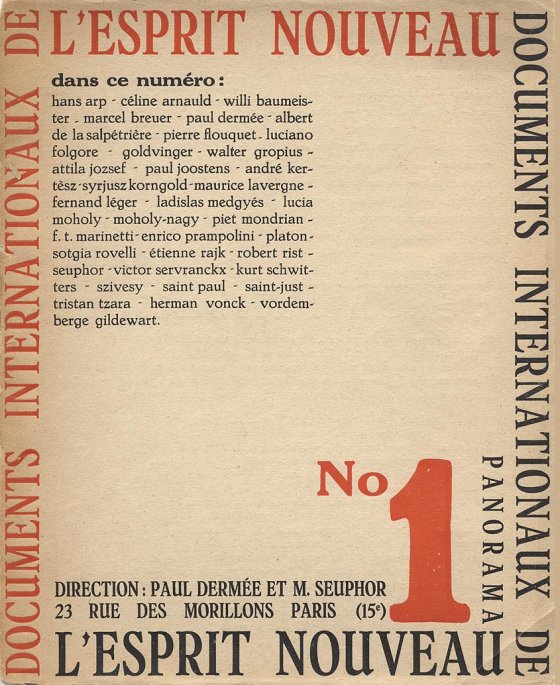|
Cubists
Cubism is an early-20th-century avant-garde art movement that revolutionized European painting and sculpture, and inspired related movements in music, literature and architecture. In Cubist artwork, objects are analyzed, broken up and reassembled in an abstracted form—instead of depicting objects from a single viewpoint, the artist depicts the subject from a multitude of viewpoints to represent the subject in a greater context. Cubism has been considered the most influential art movement of the 20th century. The term is broadly used in association with a wide variety of art produced in Paris (Montmartre and Montparnasse) or near Paris (Puteaux) during the 1910s and throughout the 1920s. The movement was pioneered by Pablo Picasso and Georges Braque, and joined by Jean Metzinger, Albert Gleizes, Robert Delaunay, Henri Le Fauconnier, Juan Gris, and Fernand Léger. One primary influence that led to Cubism was the representation of three-dimensional space, three-dimensional form in ... [...More Info...] [...Related Items...] OR: [Wikipedia] [Google] [Baidu] |
Jean Metzinger
Jean Dominique Antony Metzinger (; 24 June 1883 – 3 November 1956) was a major 20th-century French painter, theorist, writer, critic and poet, who along with Albert Gleizes wrote the first theoretical work on Cubism. His earliest works, from 1900 to 1904, were influenced by the neo-Impressionism of Georges Seurat and Henri-Edmond Cross. Between 1904 and 1907 Metzinger worked in the Divisionist and Fauvist styles with a strong Paul Cézanne, Cézannian component, leading to some of the first Proto-Cubism, proto-Cubist works. From 1908 Metzinger experimented with the faceting of form, a style that would soon become known as Cubism. His early involvement in Cubism saw him both as an influential artist and an important theorist of the movement. The idea of moving around an object in order to see it from different view-points is treated, for the first time, in Metzinger's ''Note sur la Peinture'', published in 1910.Jean Metzinger, October–November 1910, "Note sur la peinture" Pan: ... [...More Info...] [...Related Items...] OR: [Wikipedia] [Google] [Baidu] |
Salon D'Automne
The Salon d'Automne (; en, Autumn Salon), or Société du Salon d'automne, is an art exhibition held annually in Paris, France. Since 2011, it is held on the Champs-Élysées, between the Grand Palais and the Petit Palais, in mid-October. The first Salon d'Automne was created in 1903 by Frantz Jourdain, with Hector Guimard, George Desvallières, Eugène Carrière, Félix Vallotton, Édouard Vuillard, Eugène Chigot and Maison Jansen.Salon d'automne; Société du Salon d'automne Catalogue des ouvrages de peinture, sculpture, dessin, gravure, architecture et art décoratif. Exposés au Petit Palais des Champs-Élysées, 1903 Perceived as a reaction against the conservative policies of the official Paris Salon ... [...More Info...] [...Related Items...] OR: [Wikipedia] [Google] [Baidu] |
Albert Gleizes
Albert Gleizes (; 8 December 1881 – 23 June 1953) was a French artist, theoretician, philosopher, a self-proclaimed founder of Cubism and an influence on the School of Paris. Albert Gleizes and Jean Metzinger wrote the first major treatise on Cubism, ''Du "Cubisme"'', 1912. Gleizes was a founding member of the Section d'Or group of artists. He was also a member of ''Der Sturm'', and his many theoretical writings were originally most appreciated in Germany, where especially at the Bauhaus his ideas were given thoughtful consideration. Gleizes spent four crucial years in New York, and played an important role in making America aware of modern art. He was a member of the Society of Independent Artists, founder of the Ernest-Renan Association, and both a founder and participant in the Abbaye de Créteil. Gleizes exhibited regularly at Léonce Rosenberg's ''Galerie de l’Effort Moderne'' in Paris; he was also a founder, organizer and director of Abstraction-Création. From the mid-1 ... [...More Info...] [...Related Items...] OR: [Wikipedia] [Google] [Baidu] |
Art Deco
Art Deco, short for the French ''Arts Décoratifs'', and sometimes just called Deco, is a style of visual arts, architecture, and product design, that first appeared in France in the 1910s (just before World War I), and flourished in the United States and Europe during the 1920s and 1930s. Through styling and design of the exterior and interior of anything from large structures to small objects, including how people look (clothing, fashion and jewelry), Art Deco has influenced bridges, buildings (from skyscrapers to cinemas), ships, ocean liners, trains, cars, trucks, buses, furniture, and everyday objects like radios and vacuum cleaners. It got its name after the 1925 Exposition internationale des arts décoratifs et industriels modernes (International Exhibition of Modern Decorative and Industrial Arts) held in Paris. Art Deco combined modern styles with fine craftsmanship and rich materials. During its heyday, it represented luxury, glamour, exuberance, and faith in socia ... [...More Info...] [...Related Items...] OR: [Wikipedia] [Google] [Baidu] |
Vorticism
Vorticism was a London-based Modernism, modernist art movement formed in 1914 by the writer and artist Wyndham Lewis. The movement was partially inspired by Cubism and was introduced to the public by means of the publication of the Vorticist manifesto in ''Blast (magazine), Blast'' magazine. Familiar forms of representational art were rejected in favour of a geometric style that tended towards a hard-edged Abstract art, abstraction. Lewis proved unable to harness the talents of his disparate group of avant-garde artists; however, for a brief period Vorticism proved to be an exciting intervention and an artistic riposte to Marinetti's Futurism and the post-impressionism of Roger Fry's Omega Workshops. Vorticist paintings emphasised 'modern life' as an array of bold lines and harsh colours drawing the viewer's eye into the centre of the canvas and vorticist sculpture created energy and intensity through 'direct carving'. Prelude to Vorticism In the summer of 1913 Roger Fry, wi ... [...More Info...] [...Related Items...] OR: [Wikipedia] [Google] [Baidu] |
Fernand Léger
Joseph Fernand Henri Léger (; February 4, 1881 – August 17, 1955) was a French painting, painter, sculpture, sculptor, and film director, filmmaker. In his early works he created a personal form of cubism (known as "tubism") which he gradually modified into a more Figurative art, figurative, populism, populist style. His boldly simplified treatment of modern subject matter has caused him to be regarded as a forerunner of pop art. Biography Léger was born in Argentan, Orne, Lower Normandy, where his father raised cattle. Fernand Léger initially trained as an architect from 1897 to 1899, before moving in 1900 to Paris, where he supported himself as an architectural draftsman. After military service in Versailles, Yvelines, Versailles, Yvelines, in 1902–1903, he enrolled at the School of Decorative Arts after his application to the École des Beaux-Arts was rejected. He nevertheless attended the Beaux-Arts as a non-enrolled student, spending what he described as "three empty an ... [...More Info...] [...Related Items...] OR: [Wikipedia] [Google] [Baidu] |
Robert Delaunay
Robert Delaunay (12 April 1885 – 25 October 1941) was a French artist who, with his wife Sonia Delaunay and others, co-founded the Orphism art movement, noted for its use of strong colours and geometric shapes. His later works were more abstract. His key influence related to bold use of colour and a clear love of experimentation with both depth and tone. Overview Delaunay is most closely identified with Orphism. From 1912 to 1914, he painted nonfigurative paintings based on the optical characteristics of brilliant colors that were so dynamic they would function as the form. His theories are mostly concerned with color and light and influenced many, including Stanton Macdonald-Wright, Morgan Russell, Patrick Henry Bruce, Der Blaue Reiter, August Macke, Franz Marc, Paul Klee, and Lyonel Feininger. Art Critic Guillaume Apollinaire was strongly influenced by Delaunay's theories of color and often quoted from them to explain Orphism, which he had named. Delaunay's fixations w ... [...More Info...] [...Related Items...] OR: [Wikipedia] [Google] [Baidu] |
Futurism
Futurism ( it, Futurismo, link=no) was an artistic and social movement that originated in Italy, and to a lesser extent in other countries, in the early 20th century. It emphasized dynamism, speed, technology, youth, violence, and objects such as the car, the airplane, and the industrial city. Its key figures included the Italians Filippo Tommaso Marinetti, Umberto Boccioni, Carlo Carrà, Fortunato Depero, Gino Severini, Giacomo Balla, and Luigi Russolo. Italian Futurism glorified modernity and according to its doctrine, aimed to liberate Italy from the weight of its past. Important Futurist works included Marinetti's 1909 ''Manifesto of Futurism'', Boccioni's 1913 sculpture ''Unique Forms of Continuity in Space'', Balla's 1913–1914 painting '' Abstract Speed + Sound'', and Russolo's ''The Art of Noises'' (1913). Although Futurism was largely an Italian phenomenon, parallel movements emerged in Russia, where some Russian Futurists would later go on to found groups of their o ... [...More Info...] [...Related Items...] OR: [Wikipedia] [Google] [Baidu] |
Purism
Purism, referring to the arts, was a movement that took place between 1918 and 1925 that influenced French painting and architecture. Purism was led by Amédée Ozenfant and Charles Edouard Jeanneret (Le Corbusier). Ozenfant and Le Corbusier formulated an aesthetic doctrine born from a criticism of Cubism and called it Purism: where objects are represented as elementary forms devoid of detail. The main concepts were presented in their short essay ''Après le Cubisme'' (After Cubism) published in 1918. Post World War I Le Corbusier and Ozenfant were the creators of Purism. Fernand Léger was a principle associate. Purism was an attempt to restore regularity in a war-torn France post World War I. Unlike what they saw as 'decorative' fragmentation of objects in Cubism, Purism proposed a style of painting where elements were represented as robust simplified forms with minimal detail, while embracing technology and the machine. Purism culminated in Le Corbusier’s ''Pavillon de l ... [...More Info...] [...Related Items...] OR: [Wikipedia] [Google] [Baidu] |
Orphism (art)
Orphism or Orphic Cubism, a term coined by the French poet Guillaume Apollinaire in 1912, was an offshoot of Cubism that focused on pure abstraction and bright colors, influenced by Fauvism, the theoretical writings of Paul Signac, Charles Henry and the dye chemist Michel Eugène Chevreul. This movement, perceived as key in the transition from Cubism to Abstract art, was pioneered by František Kupka, Robert Delaunay and Sonia Delaunay, who relaunched the use of color during the monochromatic phase of Cubism. The meaning of the term Orphism was elusive when it first appeared and remains to some extent vague. History The Orphists were rooted in Cubism but tended towards a pure lyrical abstraction. They saw art as the unification of sensation and color. More concerned with sensation, they began with recognizable subjects, depicted with abstract structures. Orphism aimed to vacate recognizable subject matter by concentrating exclusively on ''form'' and ''color''. The movement also ... [...More Info...] [...Related Items...] OR: [Wikipedia] [Google] [Baidu] |
Paul Cézanne
Paul Cézanne ( , , ; ; 19 January 1839 – 22 October 1906) was a French artist and Post-Impressionism, Post-Impressionist painter whose work laid the foundations of the transition from the 19th-century conception of artistic endeavour to a new and radically different world of art in the 20th century. Cézanne is said to have formed the bridge between late 19th-century Impressionism and the early 20th century's new line of artistic enquiry, Cubism. While his early works are still influenced by Romanticism – such as the murals in the Bastide du Jas de Bouffan, Jas de Bouffan country house – and Realism, he arrived at a new pictorial language through intensive examination of Impressionist forms of expression. He gave up the use of Perspective (graphical), perspective and broke with the established rules of Academic Art and strived for a renewal of traditional design methods on the basis of the impressionistic color space and color modulation principles. Cézanne's often re ... [...More Info...] [...Related Items...] OR: [Wikipedia] [Google] [Baidu] |
Henri Le Fauconnier
Henri Victor Gabriel Le Fauconnier (July 5, 1881 – December 25, 1946) was a French Cubist painter born in Hesdin. Le Fauconnier was seen as one of the leading figures among the Montparnasse Cubists. At the 1911 Salon des Indépendants Le Fauconnier and colleagues Jean Metzinger, Albert Gleizes, Fernand Léger and Robert Delaunay caused a scandal with their Cubist paintings. He was in contacts with many European avant-garde artists such as Wassily Kandinsky, writing a theoretical text for the catalogue of the Neue Künstlervereinigung München, Neue Künstlervereinigung in Munich, of which he became a member. His paintings were exhibited in Moscow reproduced as examples of the latest art in ''Der Blaue Reiter, Der Blaue Reiter Almanach'' (''The Blue Rider Almanac''). Career In 1901 Henri Le Fauconnier moved from northern France to Paris, where he studied law, then attended painting classes in the studio of Jean-Paul Laurens, then in the Academie Julian. He changed his name from ... [...More Info...] [...Related Items...] OR: [Wikipedia] [Google] [Baidu] |




_interior.jpg)
.jpg)





